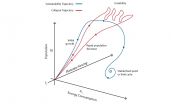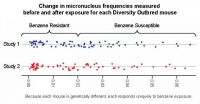(Press-News.org) Toronto, ON - For most cancer patients, primary tumours are often not the most deadly. Instead, it is the metastatic tumours - tumours that spread from their original location to other parts of the body - that are the cause of most cancer deaths.
The catalysts behind the formation of these deadly metastatic tumours are believed to be cancer cells that are launched into the bloodstream from the original site of the cancer. Researchers are very interested in leveraging these circulating tumour cells, or CTCs, which have the potential to allow the properties of a tumour to be better understood without a biopsy, and may also help physicians recognize how aggressive a tumour is and whether it is likely to cause metastatic disease.
However, not all CTCs in a given patient are alike. Recent discoveries have shown that CTCs
are highly heterogeneous - with individual cancer cells possessing very different molecular characteristics - and that only a small subset of these cells actually possess the metastatic potential to spread the disease throughout the body.
Current technologies exist that allow these circulating cells to be captured from the blood of
cancer patients, but they are not well equipped to differentiate between the various CTCs present in the blood sample. Instead, they simply count the number of CTCs in a patient sample, rather than identifying the cells that possess the highest metastatic potential. As a result, these tools are less than ideal as they are only able to provide general information on the levels of CTCs rather than a more focused understanding of the disease and its aggressiveness.
Researchers at the Leslie Dan Faculty of Pharmacy at the University of Toronto have
developed a new device that provides a way to visualize the heterogeneity of CTCs, and have published their findings in the leading Chemistry journal Angewandte Chemie. Using nanoparticles to tag cells, this device sorts the CTCs collected in a sample into discrete subpopulations based on the phenotype of the cells, and provides a snapshot of the nature of the tumour cells present in patients' blood.
"Recognizing that characterizing the phenotype of circulating tumour cells is more useful for cancer management than quantitating the cells present in a blood sample, we set out to devise a method that would allow us to capture and distinguish between these cells," notes Professor Shana Kelley of the Leslie Dan Faculty of Pharmacy. "In the lab, we were able to demonstrate that the tool was not only highly effective at differentiating these cells, but also proved to be more sensitive than the current leading methods of cellular sorting."
Partnering with collaborators at the Sunnybrook Health Sciences Centre and the London Health Sciences Centre, the researchers collected samples from prostate cancer patients to test the efficacy and ability of the diagnostic platform.
"Through this study, over 20 patients with localized prostate cancer were tested," notes Dr. Robert Nam, Ajmera Chair in Urologic Oncology and Head of Genitourinary Oncology, at Sunnybrook's Odette Cancer Centre . "Interestingly, significant levels of these circulating tumour cells were observed in all of the patients. Even more intriguing was the observation of very different subpopulation profiles across this group of patients that all received very similar clinical diagnoses, indicating that molecular-‐level difference may exist in the patients' tumours."
While this study only involved a small number of patients, further validation is planned with several other cancers, including breast, colon, ovarian, lung, and pancreatic cancer.
"Ultimately, we believe that this sensitive technology possesses the potential to provide more useful information about these cells, leading to better diagnoses and improved patient outcomes," notes Dr. Kelley.
"As a result, we are excited to pursue new research opportunities in an effort to more accurately and less invasively diagnose and improve the health outcomes for cancer patients."
INFORMATION:
The NASA/ESA Hubble Space Telescope has snapped a striking view of a multiple star system called XZ Tauri, its neighbour HL Tauri, and several nearby young stellar objects. XZ Tauri is blowing a hot bubble of gas into the surrounding space, which is filled with bright and beautiful clumps that are emitting strong winds and jets. These objects illuminate the region, creating a truly dramatic scene.
This dark and ominous landscape is located some 450 light-years away in the constellation of Taurus The Bull). It lies in the north-eastern part of a large, dark cloud known ...
Engineers at the University of California, San Diego, are proposing a new surgical intervention for children born with a single ventricle in their heart--instead of the usual two. The new approach would potentially reduce the number of surgeries the patients have to undergo in the first six months of life from two to just one. If successful, it would also create a more stable circuit for blood to flow from the heart to the lungs and the rest of the body within the first days and months of life.
Engineers ran computer simulations of the surgery and found it would reduce ...
Scientists at Helmholtz Zentrum München (HMGU), at Karolinska Institutet (KI), Stockholm and the University College London investigated the function of ciliary cell extensions in the pancreas. Stimulation of the insulin-producing beta cells increases the number of insulin receptors on their cilia. The cilia consequently play an important role in the release and signal transduction of insulin, a hormone that reduces sugar levels.
Defective cilia lead to elevated blood sugar levels and lowered insulin release
The lead author of the paper Dr. Jantje Gerdes, formerly ...
Human-caused climate change, ocean acidification and species extinctions may eventually threaten the collapse of civilization, according to some scientists, while other people argue that for political or economic reasons we should allow industrial development to continue without restrictions.
In a new paper, two astrophysicists argue that these questions may soon be resolvable scientifically, thanks to new data about the Earth and about other planets in our galaxy, and by combining the earth-based science of sustainability with the space-oriented field of astrobiology.
"We ...
This news release is available in German.
"The technique makes it possible for the first time to remove large organic molecules from associated structures and place them elsewhere in a controlled manner," explains Dr. Ruslan Temirov from Jülich's Peter Grünberg Institute. This brings the scientists one step closer to finding a technology that will enable single molecules to be freely assembled to form complex structures. Research groups around the world are working on a modular system like this for nanotechnology, which is considered imperative for the ...
New research reports that the rate of hospitalization due to hepatitis A virus (HAV) infection has significantly declined in the U.S. from 2002 to 2011. Findings published in Hepatology, a journal of the American Association for the Study of Liver Diseases, show that older patients and those with chronic liver disease are most likely to be hospitalized for HAV. Vaccination of adults with chronic liver disease may prevent infection with hepatitis A and the need for hospitalization.
The World Health Organization (WHO) estimates that each year 1.4 million individuals worldwide ...
A genetically diverse mouse model is able to predict the range of response to chemical exposures that might be observed in human populations, researchers from the National Institutes of Health have found. Like humans, each Diversity Outbred mouse is genetically unique, and the extent of genetic variability among these mice is similar to the genetic variation seen among humans.
Using these mice, researchers from the National Toxicology Program (NTP), an interagency program headquartered at the National Institute of Environmental Health Sciences (NIEHS), were able to identify ...
WASHINGTON, D.C., November 6, 2014--Short-term certificate programs at community colleges offer limited labor-market returns, on average, in most fields of study, according to new research published today in Educational Evaluation and Policy Analysis (EEPA), a peer-reviewed journal of the American Educational Research Association. The results of the study, which focused on community college programs in Washington State, are in line with recent research in other states (Kentucky, North Carolina, and Virginia) that found only small economic returns from short-term programs. ...
WASHINGTON, DC (November 6, 2014)--In honor of Veterans Day, the peer-reviewed journal Women's Health Issues (WHI) today released a new Special Collection on women veterans' health, with a focus on mental health. The special collection also highlights recent studies addressing healthcare services, reproductive health and cardiovascular health of women veterans.
"In recent years, we have seen the Veterans Administration working to improve care and health outcomes of women veterans and service members," said Chloe Bird, editor-in-chief of Women's Health Issues. "The studies ...
Paramedics respond to a 911 call to find an elderly patient who's having difficulty breathing. Anxious and disoriented, the patient has trouble remembering all the medications he's taking, and with his shortness of breath, speaking is difficult. Is he suffering from acute emphysema or heart failure? The symptoms look the same, but initiating the wrong treatment regimen will increase the patient's risk of severe complications.
Researchers from MIT's Research Laboratory of Electronics, working with physicians from Harvard Medical School and the Einstein Medical Center in ...





